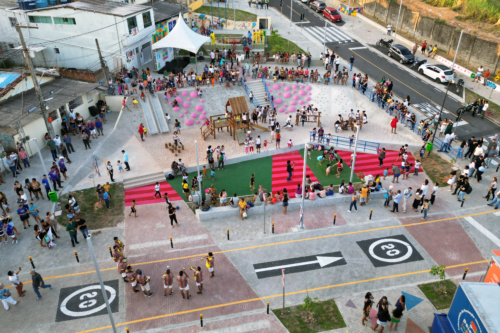14 Junio, 2022
Global Designing Cities Initiative (GDCI) ha publicado hoy la traducción al español de Designing Streets for Kids (Diseño de calles para la niñez), un suplemento de la Guía Global de Diseño de Calles (GSDG por sus siglas en inglés) de la GDCI, que establece una nueva base mundial para el diseño de calles urbanas. Diseño de Calles para la Niñez parte del enfoque de poner a las personas en primer lugar, centrándose en las necesidades específicas de bebés, niñas y niños y sus cuidadores, así como peatones, ciclistas y usuarios del tránsito en las calles urbanas de todo el mundo.
La mayoría de las calles no se construyeron pensando en los niños y, además, las condiciones actuales de las calles en muchos lugares son inseguras y poco acogedoras para ellos. Los siniestros viales matan a 1,35 millones de personas cada año y son la principal causa de muerte entre jóvenes de 5 a 29 años. Asimismo, la congestión del tráfico y el diseño de vehículos contribuyen a que los niveles de contaminación atmosférica sean peligrosamente altos, lo que es responsable de la muerte de 127.000 niños menores de cinco años cada año. Gran parte de estas muertes son evitables y estas cifras pueden reducirse drásticamente mediante un diseño de calles adecuado para la niñez.
El mal diseño de las calles también tiene consecuencias negativas para la salud física y mental de los niños. Las calles ruidosas y hostiles para peatones y usuarios del transporte público tienden a desanimar a los niños a realizar actividades físicas, lo que les priva una movilidad independiente y de oportunidades para hacer ejercicio y jugar.
Con diagramas detallados y abundantes gráficos, Diseño de calles para la niñez recoge las mejores prácticas, estrategias, programas y políticas utilizadas en todo el mundo, desde Bogotá hasta Moscú. La guía presta especial atención al rediseño de calles en lugares estratégicos, como escuelas y calles de barrios, zonas de mucho tráfico, así como en calles comerciales e intersecciones. Con un capítulo dedicado a “Cómo hacer realidad el cambio,” la guía también muestra cómo poner en práctica y ampliar los planes de rediseño de calles, destacando las tácticas para involucrar a los niños en todo el proceso de planificación, un enfoque que a menudo se pasa por alto y que puede transformar drásticamente la forma en que se diseñan y utilizan las calles.
“Diseño de Calles para la Niñez ofrece estrategias prácticas para garantizar un acceso equitativo a estos espacios públicos vitales,” dijo Skye Duncan, Executive Director de la GDCI. “Con la traducción de esta premiada publicación, millones de personas de todo el mundo pueden acceder a esta información en su lengua materna, contribuyendo así a garantizar que más niñas y niños sobrevivan y prosperen en sus calles locales.”
“Guayaquil tiene grandes compromisos con sus niños y niñas, uno de los más importantes es brindarles espacios seguros para su movilidad y recreación,” dijo Cynthia Viteri, alcaldesa de Guayaquil. “La traducción al español de Designing Streets for Kids abre las puertas a que se tomen decisiones en propuestas de proyectos y programas de seguridad vial basadas en las necesidades de los niños como uno de los actores principales de nuestras calles.”
“The Covid 19 pandemic and the long confinements that our children have suffered require us to respond effectively to provide our cities with safe streets for children,” said Javier Vergara Petrescu, Co-founder and Executive Director of Ciudad Emergente. “The good news is that today there is a growing interest in prioritizing cities for children and their caregivers and the Streets for Kids guide is an excellent tool to achieve this goal.”
“Si uno diseña una calle que funciona para niñas y niños, ha diseñado una calle que funciona para todas las personas,” dijo Janette Sadik-Khan, GDCI Chair and Principal with Bloomberg Associates. “Diseño de calles para la niñez muestra cómo las ciudades pueden ser líderes en el diseño para mejorar la calidad de vida de las personas en todo el mundo.”
El programa Streets for Kids de GDCI cuenta con el generoso apoyo de Bloomberg Philanthropies, la Bernard Van Leer Foundation, la FIA Foundation, y la Fondation Botnar. Diseño de calles para la niñez se puede ver y descargar gratis aquí.
June 14, 2022
The Global Designing Cities Initiative (GDCI) today released the Spanish translation of Designing Streets for Kids—a supplement to GDCI’s Global Street Design Guide (GSDG), which set a new global baseline for designing urban streets. Designing Streets for Kids builds upon the approach of putting people first, with a focus on the specific needs of babies, children, and caregivers as pedestrians, cyclists, and transit users in urban streets around the world.
Most streets were not built with children in mind, and current street conditions in many places are unwelcoming and unsafe for kids. Traffic crashes kill 1.35 million people every year and they are the leading cause of death for young people ages 5-29. Traffic congestion and vehicle designs can also contribute to dangerously high levels of air pollution, which is responsible for the death of 127,000 children under the age of five each year. Many of these fatalities are preventable, and these numbers can be dramatically reduced through kid-friendly street design.
Poor street design also has negative consequences for children’s physical and mental health. Streets that are noisy and/or hostile to pedestrians and transit users tend to discourage physical activity, which deprives children of independent mobility and opportunities to exercise and play.
Offering detailed diagrams and rich graphics, Designing Streets for Kids captures best practices, strategies, programs, and policies used globally by cities from Bogotá to Moscow. The guide pays special attention to street redesigns in key places, such as schools and neighborhood streets, as well as high-traffic areas including commercial streets and intersections. With a dedicated chapter on “How to Make Change Happen,” the guide also shows how to implement and scale-up street redesign plans, highlighting tactics to engage children throughout the planning process—an often-overlooked approach that can dramatically transform how streets are designed and used.
“Reliable mobility options and access to safe, healthy streets is a human right, and Designing Streets for Kids provides actionable strategies for ensuring equitable access to these vital public spaces,” said Skye Duncan, Executive Director of GDCI. “With the translation of this award-winning publication, millions more people across the globe can access this information in their native language, helping to ensure that more kids survive and thrive on their local streets.”
“Guayaquil has great commitments to its children, one of the most important is to provide them with safe spaces for their mobility and recreation,” said Cynthia Viteri, Mayor of Guayaquil. “The Spanish translation of Designing Streets for Kids opens the door for decisions to be made on road safety projects and programs proposals based on the needs of children as one of the main users on our streets.”
“The Covid 19 pandemic and the long confinements that our children have suffered require us to respond effectively to provide our cities with safe streets for children,” said Javier Vergara Petrescu, Co-founder and Executive Director of Ciudad Emergente. “The good news is that today there is a growing interest in prioritizing cities for children and their caregivers and the Streets for Kids guide is an excellent tool to achieve this goal.”
“If you design a street that works for kids, you’ve designed a street that works for everyone,” said Janette Sadik-Khan, GDCI Chair and Principal with Bloomberg Associates. “Designing Streets for Kids shows how cities can lead by design to improve the quality of life for people everywhere.”
GDCI’s Streets for Kids program is generously supported by Bloomberg Philanthropies, the Bernard Van Leer Foundation, the FIA Foundation, and Fondation Botnar. Designing Streets for Kids can be viewed and downloaded for free here.


